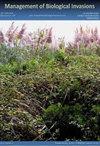Host associations between xylophagous longhorn beetles (Coleoptera: Cerambycidae) and American commodity tree species from Chinese collection sources
IF 1.2
4区 环境科学与生态学
Q3 BIODIVERSITY CONSERVATION
引用次数: 2
Abstract
A small number of longhorn beetle species (Coleoptera: Chrysomeloidea: Cerambycidae) have the potential to become invasive forest pests. International trade in live plants and wood packaging material are known invasion pathways for longhorn beetles. Once an invasive pest is intercepted in a new region, a rapid pest risk analysis is often needed to determine the appropriate response. For accurate risk quantification, natural history evidence is necessary. This information is also vital in preventing introduction. This study gathered insect collection data, especially references to host plants, of xylophagous longhorn beetles from the Institute of Zoology, Chinese Academy of Sciences, Beijing, China. Beetle associations with three important host groups were investigated: Fagaceae, Citrus spp., and avocado (Persea americana). We performed a systematic literature review to identify previously documented cerambycidae associated with these plants. Here, we report insect-plant host associations for 39 species of longhorn beetles based on a review of the literature; 43 interactions were documented, 10 interactions were novel. No host associations were recorded with avocado in China. This information serves as a foundation for pest risk analysis in determining threats posed by potentially invasive longhorn beetles into new regions.食木角甲虫(鞘翅目:天牛科)与美国商品树种寄主关系的研究
少数长角甲虫(鞘翅目:金牛总科:天牛科)具有成为森林入侵害虫的潜力。活植物和木质包装材料的国际贸易是已知的角牛甲虫入侵途径。一旦在一个新的地区截获了一种入侵有害生物,通常需要对有害生物风险进行快速分析,以确定适当的应对措施。为了准确地量化风险,自然历史证据是必要的。这一信息对于防止传播也是至关重要的。本研究收集了中国科学院北京动物研究所木食天牛的昆虫采集资料,特别是寄主植物的参考资料。研究了甲虫与壳斗科、柑橘科和鳄梨(Persea americana)这三个重要寄主类群的关联。我们进行了系统的文献综述,以确定先前记录的与这些植物相关的天牛科。本文在文献综述的基础上,报道了39种长角甲虫的昆虫-植物寄主关系;43种相互作用被记录下来,10种相互作用是新的。在中国没有记录到牛油果与宿主的关联。这些信息可作为害虫风险分析的基础,以确定潜在入侵的长角甲虫对新地区构成的威胁。
本文章由计算机程序翻译,如有差异,请以英文原文为准。
求助全文
约1分钟内获得全文
求助全文
来源期刊

Management of Biological Invasions
Agricultural and Biological Sciences-Ecology, Evolution, Behavior and Systematics
CiteScore
3.40
自引率
6.70%
发文量
21
审稿时长
16 weeks
期刊介绍:
Management of Biological Invasions, established in 2010 by Dr. Elias Dana, is an open access, peer-reviewed international journal focusing on applied research in biological invasions in aquatic and terrestrial ecosystems from around the world. This journal is devoted to bridging the gap between scientific research and the use of science in decision-making, regulation and management in the area of invasive species introduction and biodiversity conservation.
Managing biological invasions is a crisis science, with Management of Biological Invasions aiming to provide insights to the issues, to document new forms of detection, measurements and analysis, and to document tangible solutions to this problem.
In addition to original research on applied issues, Management of Biological Invasions publishes technical reports on new management technologies of invasive species and also the proceedings of relevant international meetings. As a platform to encourage informed discussion on matters of national and international importance, we publish viewpoint papers that highlight emerging issues, showcase initiatives, and present opinions of leading researchers.
 求助内容:
求助内容: 应助结果提醒方式:
应助结果提醒方式:


